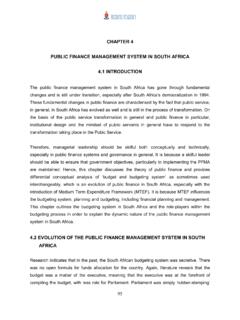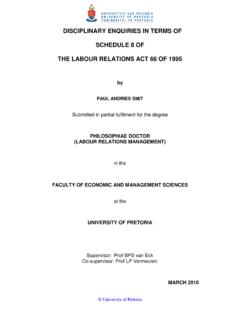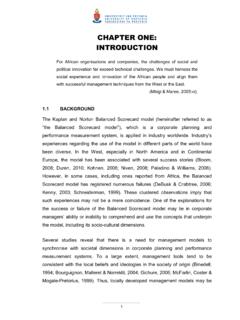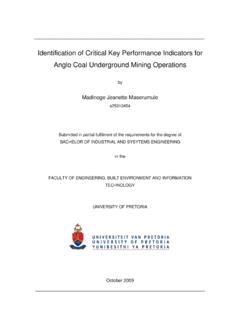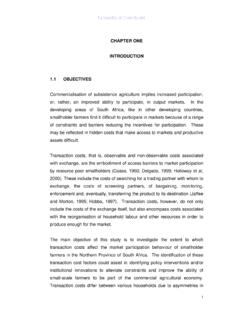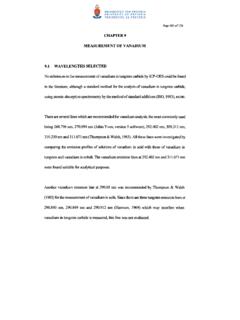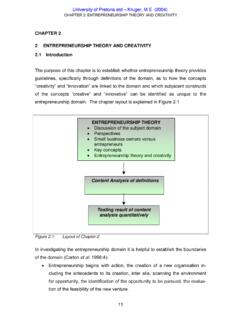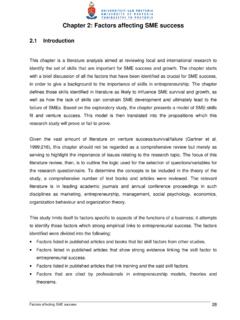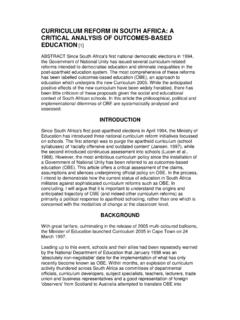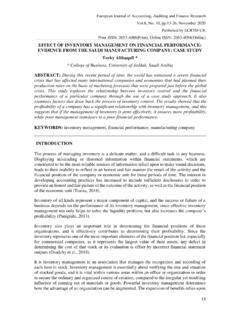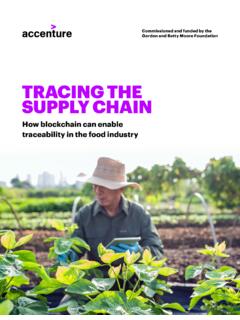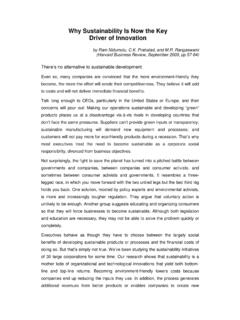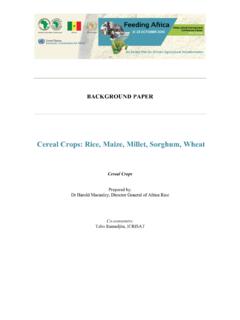Transcription of An analysis of constraints facing smallholder farmers in the ...
1 An analysis of constraints facing smallholder farmers in the Agribusiness value chain : A case study of farmers in the Limpopo Province By Joshua Kenneth Baloyi Submitted in partial fulfilment of the requirements of the degree M Inst Agrar (Agricultural Economics). in the Department of Agricultural Economics, Extension and Rural Development Faculty of Natural and Agricultural Sciences University of Pretoria Pretoria University of Pretoria MAY 2010. i ACKNOWLEDGEMENTS. I am grateful for the privilege of working with my insightful, knowledgeable supervisors, Professor Andr Louw and Professor Johann Kirsten. It was their advice and motivation throughout the process that enabled me to achieve my objective of completing this study . The preparation and writing up of this research proved to be extremely difficult and time consuming. However, the task was made considerably easier by the capable and energetic supervision of Professor Louw in particular, who advised me from the initial stage until the final stage of this study .
2 I am highly indebted to him for providing me with inspiration, encouragement and advice along the way. I also wish to extend my appreciation to Professor Kirsten for providing substantial and constructive comments on earlier drafts of the manuscript, along with helpful suggestions that assisted me in preparing the final draft. My sincere thanks also go to the Limpopo Department of Agriculture for providing the generous financial assistance that made this study possible. Here I want to thank specifically the head of the department, Mr Bigman Maloa, who has always encouraged his staff to use the department's bursary opportunity to further their studies. I also wish to express my appreciation to Dirane, Molepo and other extension officers from the Limpopo Department of Agriculture for their assistance in the data-collection process. There are no words to express my profound gratitude to my parents, Samuel and Rosina Baloyi, for their guidance and support throughout my studies at the University of Pretoria.
3 My sincere thanks also go to the faculty, staff and fellow graduates at the university for their support and friendship. Last but not least, I wish to acknowledge Mmaphodo, Tema, N. Sithole, and P. Khwekhwe for their unfailing encouragement throughout. i DECLARATION. I, Joshua Kenneth Baloyi, declare that this dissertation, submitted for the degree M Inst Agrar (Agricultural Economics) at the University of Pretoria, is my own work. It has not been submitted before for any other degree or examination at any other university. All sources used or quoted have been properly indicated and acknowledged by means of complete references. Signature: .. Date: . ii DEDICATION. I proudly dedicate this work to the Lord God, without whom it would not have been possible to complete this research paper. I have witnessed His faithfulness in providing for my needs every step of the way, and in leading me into experiences far better than I.
4 Could have hoped for or imagined. Whatever I have learnt, and whatever this endeavour has produced, is by His grace alone. iii An analysis of constraints facing smallholder farmers in the Agribusiness value chain A case study of farmers in the Limpopo Province By Joshua Kenneth Baloyi Degree : M Inst Agrar (Agricultural Economics). Department : Agricultural Economics, Extension and Rural Development Supervisor : Prof. A. Louw Co-supervisor : Prof. Kirsten ABSTRACT. This study focused on analysing the production and marketing constraints that often prevent smallholder farmers from accessing high- value markets in the agribusiness value chain . Access to markets is an essential requirement for the poor in rural areas to enjoy the benefits of agricultural growth. Limited access to agricultural markets by smallholder farmers in rural areas represents one of the most important challenges confronting policymakers in developing countries.
5 Several studies have indicated how smallholder farmers can be linked to markets, but they have failed to address issues of how to increase the likelihood of smallholder farmers benefiting from high- value markets. Due to the stringent sourcing criteria of formal markets, small-scale farmers are excluded from the agricultural value chains. It may be easy to access the market, but it is very difficult for smallholder farmers to retain that market. This is attributed to the fact that smallholder farmers face various constraints along the value chain such as production and marketing constraints . iv The main objective of this study was to identify and analyse the constraints confronting smallholder farmers in the Limpopo Province and to suggest different strategies that can be used to make it easier for smallholder farmers to access high- value markets in the agribusiness value chain . This was achieved through personal interviews in two districts, the Capricorn and Vhembe districts.
6 Primary data was obtained through structured questionnaires in both districts. These two districts were chosen due to their uniqueness with regard to agricultural potential, with smallholder farmers in both districts being heterogeneous and confronting different constraints in producing and marketing their products. Producing for the market calls for production resources, including production means such as land, water, on-farm and off-farm infrastructure, labour force, capital, and good management of these resources. Poor access to these resources affects the way in which smallholder farmers can benefit from opportunities in agricultural markets, especially in terms of the volume of products traded and the quality and quantity of those products. Based on the surveys employed for purposes of this study , the participation of smallholder farmers in high- value markets is constrained as a result of poor access to comprehensive agricultural support services.
7 There are relatively few direct linkages between smallholder farmers and fresh produce markets, supermarkets, and agro- processors. The majority of sales by farmers are at either the local market or the farm gate level. Few farmers have access to basic production equipment and infrastructure. A range of impediments to participation in high- value markets were identified. These include lack of access to sufficient and productive land for expansion, sufficient water, modern irrigation systems, mechanisation, transport logistics, and market information. These constraints constitute the greatest barrier for smallholder farmers when it comes to accessing high- value markets, and overcoming these constraints is critical if smallholder farmers are to access lucrative markets. There is relatively low participation among farmers in collective action, more especially at production and marketing levels. v The study found that smallholder farmers in the Vhembe district have a comparative advantage in terms of vegetable production compared to those in the Capricorn district.
8 smallholder farmers in the Vhembe district are better linked to agro-processors, fresh- produce markets and supermarkets as compared to farmers in the Capricorn district . even though this is the case for only a few individual farmers . The study also found that individual producers have greater access to on-farm infrastructure and also perform better and have closer links to formal markets compared to projects owned by groups of households. The results of the study suggest that smallholder farmers who are currently not participating in high- value markets could improve their participation if they are given access to comprehensive agricultural support services. More attention must be given to supporting smallholder farmers in both districts to ensure that they engage in commercial production and participate in high- value markets on a sustainable basis. This could only happen if their constraints along the value chain are addressed.
9 The major challenge confronting policymakers is to create an enabling environment for smallholder farmers and empower them to produce high volumes of good-quality products on a consistent and sustainable basis. vi TABLE OF CONTENTS. PAGE. ACKNOWLEDGEMENTS ..i DECLARATION . ii DEDICATION ..iii ABSTRACT ..iv LIST OF TABLES ..xii LIST OF FIGURES ..xii LIST OF ABBREVIATIONS AND ACRONYMS ..xiii CHAPTER 1. INTRODUCTION. Introduction and background..1. Objectives of the study ..3. Problem statement .4. Research questions and research gaps .. 4. Provincial outlook .. 5. Research process and .7. Choice of districts 7. Choice of commodities .. 7. Data collection methods ..8. Tomato production in the Limpopo 9. Potato production in the Limpopo province .. 10. Justification of the study .. 11. Outline of the study .. 12. vii CHAPTER 2. LITERATURE REVIEW. Introduction .. 13. New paradigm of agribusiness 13. Agro-food markets and smallholder farmers .
10 15. Market reforms and smallholder farmers .. 17. Agricultural value chain approach and smallholder farmers .. 18.. 21. CHAPTER 3. constraints facing smallholder farmers . Introduction .. 22. Internal and external constraints facing smallholder 22. Marketing constraints facing smallholder farmers .. 23. Lack of human capital .. 24. constraints on production ..24. High transaction costs .. 24. Lack of on-farm infrastructure ..25. Asymmetry or lack of information on markets ..25. Low quantity and poor quality ..25. Inconsistency in production ..26. Transportation problems ..26. Lack of markets in rural areas ..26. Lack of bargaining power ..26. Regulatory barriers ..27. Technological barriers ..27. Agricultural support programmes for smallholder farmers .. 28. What can be learnt from the Farmer Support Programme of the late 1980s?..28. Comprehensive Agricultural Support Programme (CASP) ..32. CASP and market access.

